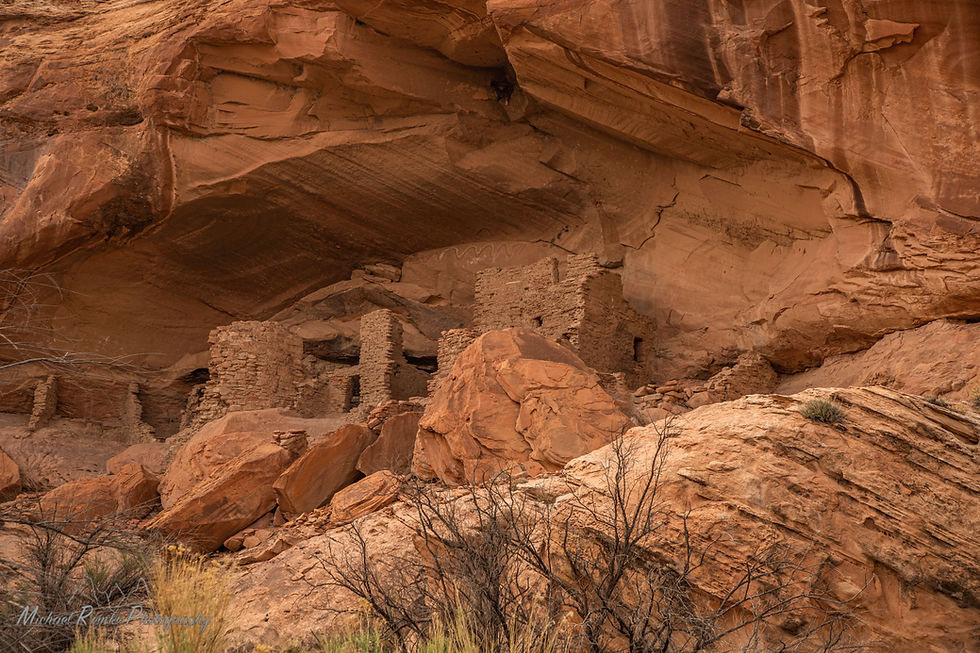The walls of Honaker Limestone towered overhead. Shear cliffs of an ancient sea dwarfed the spatial and temporal scale of the moment. Water gurgled in the currents of the San Juan River as it flowed through the deep canyon, isolated from the vast dry desert that surrounds this particular place. Above all these features, the cracking of out of tune, slight drunk, human signing swept perspective towards humanity.

The non-human world has long enamored me. The deep complexity of the river cutting through monoclines and anticlines, flowing from the San Juan Mountains towards to Colorado River, is a perspective that feels impossibly complex. Layer in the details of the geologic past - the remnants of ancient seaways and dune fields, cobbles of granite and volcanic rock carried from the mountains. It appears there is a lifetime of observation to come to understand place. Shift the perspective from the non-human perspective of place and the river itself becomes a symbol of division - the left bank is the Navajo Nation, the Right is Bureau of Land Management Land, yet the right shore is decorated with Moki Steps, Petroglpyhs, and dwellings of peoples that occupied place for centuries-millennia well before Saint John the Baptist became the name of this place. The modern day Ute and Diné continue to live and thrive in these places despite the struggles of social-economic inequality. Oil pads, uranium mines, mine spills pollute the lands and waters to feed the thriving privilege of Americans who have never before laid eyes on these landscapes.

Narrow the time scale to the last 100 years and the perspective changes more - the olive green of Russian Olive, the loose branching of Tamrisk, some defoliated by an introduced beetle, trees planted by anglo-settlers come to the focus of attention. Humans have long shaped ecosystems - the people who have lived here for millennia altered plant communities by cultivating specific plants and harboring a deep connection with plants that sustain their health and livelihood with considerable intentionality. Today, alterations to landscapes seem baffling in the pronounced lack of intentional use of land. Over consumptive demands for water and plants have reduced once sprawling bosques of cottonwood galleries to mere scattered trees intermixed with the olive-green Russian olive. Once wild flowing rivers loath to trickles, with significant dams impending their flow and trapping sediment.

As ripples swirled into eddies in the river, and the density of thought on the complexity of a river and its ecosystem consumed much of my reflection, a strong wind howled, pushing perspective away and bringing new thoughts. The gusts were strong enough that white-capped waves broke against the flow of the river and traveling upstream became a more logical direction than continuing downstream. The air swirled with red dust and deep haze. Winds on the Colorado Pleateau are bar none strong in spring. Pressure gradients as the cold months of winter linger in the high mountains, and the deserts slowly warm with lengthening days brings about a consistent Southwest wind. The cross-bedded nature of many sandstones on the Colorado Plateau offer a geologic view into the consistency of these phenomena, yet the deep red haze offers a slight of hand of how the land away from the river has changed. By in large, grazing and other disturbances have increased the amount of bare soil exposed, thus increasing susceptibility to wind erosion - the result is dust. The strong winds push the dust to the high mountains where dust on snow accelerates snow melt, reducing available water to ecosystems and humanity. The juxtaposing flow of the river and push of the wind brought about exhaustion in both mind and body.

In the silence between gusts of winds, the noise of drunken lullaby came racing back. Humans - laughing, contextual-less jubilations and exclamations. Could these complex thoughts be too over bearing, especially given the potential complexities of situations not included in the flow of the river? I am sure my own emails were piling up - asks for work, duties and responsibilities - bills to pay. Moments of curiosity - desires to quit jobs, barriers and hinderances to self-expression. It seems getting a group of humans together means there is potential for infinite story and perspective - and opportunity to let complexity blow away and opt for simplicity.
What is the perspective of the collective, of the group?
"If tired of trees I seek again mankind, Well I know where to hie me—in the dawn, To a slope where the cattle keep the lawn. There amid lolling juniper reclined, Myself unseen, I see in white defined Far off the homes of men, and farther still The graves of men on an opposing hill, Living or dead, whichever are to mind.
And if by noon I have too much of these, I have but to turn on my arm, and lo, The sunburned hillside sets my face aglow, My breathing shakes the bluet like a breeze, I smell the earth, I smell the bruisèd plant, I look into the crater of the ant."
- The Vantage Pont, Robert Frost.
For more reaidng on some thoughts included in this post see:
1. Pavlik, B. M. et al. Plant species richness at archaeological sites suggests ecological legacy of Indigenous subsistence on the Colorado Plateau , USA . 1–17 (2021) doi:10.1073/pnas.2025047118.
2. Munson, S. M., Belnap, J. & Okin, G. S. Responses of wind erosion to climate-induced vegetation changes on the Colorado Plateau. Proc. Natl. Acad. Sci. U. S. A. 108, 3854–3859 (2011).
3. Painter, T. H. et al. Response of Colorado River runoff to dust radiative forcing in snow. Proc. Natl. Acad. Sci. 107, 17125–17130 (2010).
4. Shoemake, T. A climatology of High Wind Warning Events for Northern and Central New Mexico: 1976-2005. NWS WFO Albuquerque (2010).

Comments